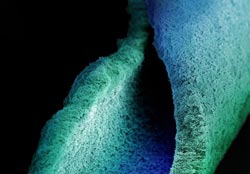Well protected: Pathogens in Biofilm

Pathogens in Biofilm: Pseudomonas aeruginosa, a causative agent for pneumonia. (Photo: University of Basel)<br>
The scientists in Prof. Urs Jenal’s team at the Biozentrum of the University of Basel have discovered that genetic modifications in a pathogen causing pneumonia help it to persist life-long in the lungs of a patient. The findings are published in the current issue of the journal PLoS Pathogens.
Living in a community provides protection from unfavorable external influences and improves the survival chances of each single individual. A pathogen of pneumonia, Pseudomonas aeruginosa, exploits this advantage. It produces a harmful biofilm in the lungs of patients with cystic fibrosis, causing chronic infections which permanently damage the lung tissue. A particularly resistant form of this pathogen is the small colony variant (CSV). Bacteria of this type coat themselves in an extremely thick matrix of a sticky polysaccharide compound, which enables strong adhesion of the biofilm to the surface of the lung.
Chronic infections through modified pathogens
The production of the polysaccharide compound is regulated by three proteins interacting in close cooperation with each other. As Urs Jenal’s team at the Biozentrum of the University of Basel have been able to demonstrate for the first time, that mutations in these proteins lead to the development of strongly adhesive SCV bacteria.
In altering single protein building blocks, the scientists disrupted the finely tuned interactions between the three proteins and thus activated the signaling pathway for the production of the sticky polysaccharide matrix.
In a second step, the researchers investigated whether such modifications contribute to the pneumonia pathogen’s life-long persistence in the lungs of patients with cystic fibrosis. To do this they isolated the SCV bacteria in samples from patients and examined their DNA.
“Our research group could find various mutations in the blueprint for the proteins. Amongst them, the same mutations that we had previously identified as causing activation.” explained Jenal. “These genetic mutations contribute as a causing factor to the production of the stable bacterial biofilm of Pseudomonas aeruginosa.”
The survival advantage of a microbial community
In people who have cystic fibrosis, the pathogen of the SCV type can withstand challenges from the immune system and antibiotics better than normal bacteria. They are the source of the repeated new break-outs of pulmonary infections and ultimately the main cause of the fatal course of the disease. With their newly acquired knowledge, Jenal and his team would now like to develop new methods, to combat the pathogens effectively and thus prevent chronic lung infections.
Original Article
Jacob G. Malone, Tina Jaeger, Pablo Manfredi, Andreas Dötsch, Andrea Blanka, Guy R. Cornelis, Susanne Häussler and Urs Jenal
The YfiBNR signal transduction mechanism reveals novel targets for the evolution of persistent Pseudomonas aeruginosa in cystic fibrosis airways
PLoS Pathogens, published 14 Jun 2012 | doi: 10.1371/journal.ppat.1002760
Media contact
Prof. Dr. Urs Jenal, University of Basel, Biozentrum, Growth & Development and Infection Biology, Klingelbergstrasse 50/70, 4056 Basel, Tel: +41 61 267 21 35, E-Mail: urs.jenal@unibas.ch
Media Contact
All latest news from the category: Life Sciences and Chemistry
Articles and reports from the Life Sciences and chemistry area deal with applied and basic research into modern biology, chemistry and human medicine.
Valuable information can be found on a range of life sciences fields including bacteriology, biochemistry, bionics, bioinformatics, biophysics, biotechnology, genetics, geobotany, human biology, marine biology, microbiology, molecular biology, cellular biology, zoology, bioinorganic chemistry, microchemistry and environmental chemistry.
Newest articles

Properties of new materials for microchips
… can now be measured well. Reseachers of Delft University of Technology demonstrated measuring performance properties of ultrathin silicon membranes. Making ever smaller and more powerful chips requires new ultrathin…

Floating solar’s potential
… to support sustainable development by addressing climate, water, and energy goals holistically. A new study published this week in Nature Energy raises the potential for floating solar photovoltaics (FPV)…

Skyrmions move at record speeds
… a step towards the computing of the future. An international research team led by scientists from the CNRS1 has discovered that the magnetic nanobubbles2 known as skyrmions can be…





















